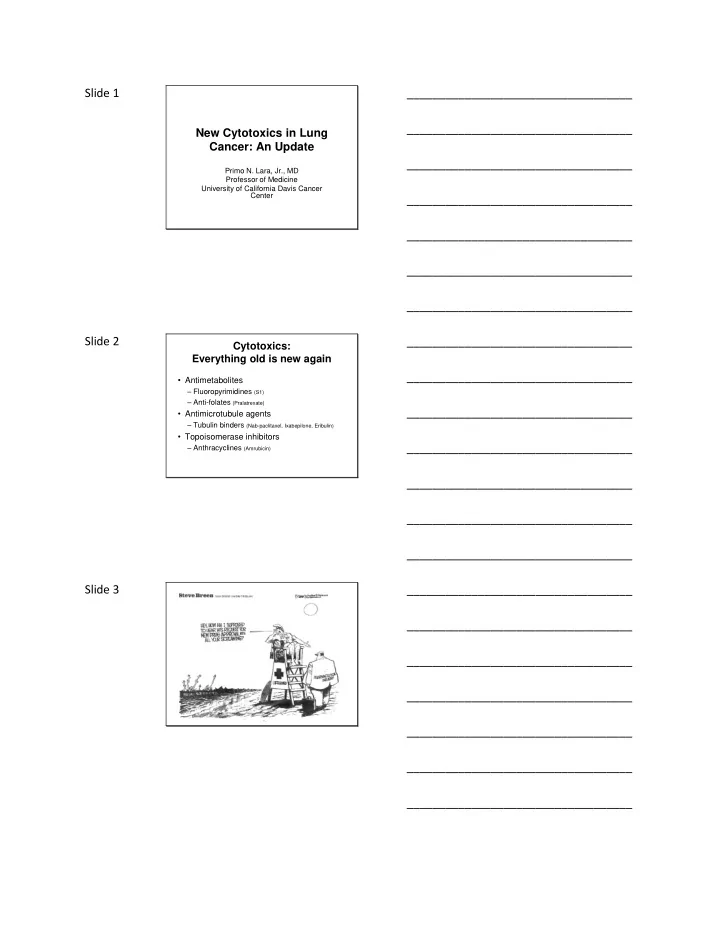

Slide 1 ___________________________________ ___________________________________ New Cytotoxics in Lung Cancer: An Update ___________________________________ Primo N. Lara, Jr., MD Professor of Medicine University of California Davis Cancer Center ___________________________________ ___________________________________ ___________________________________ ___________________________________ Slide 2 ___________________________________ Cytotoxics: Everything old is new again ___________________________________ • Antimetabolites – Fluoropyrimidines (S1) – Anti-folates (Pralatrexate) ___________________________________ • Antimicrotubule agents – Tubulin binders (Nab-paclitaxel, Ixabepilone, Eribulin) • Topoisomerase inhibitors ___________________________________ – Anthracyclines (Amrubicin) ___________________________________ ___________________________________ ___________________________________ Slide 3 ___________________________________ ___________________________________ ___________________________________ ___________________________________ ___________________________________ ___________________________________ ___________________________________
Slide 4 ___________________________________ Cytotoxics: Everything old is new again ___________________________________ • Antimetabolites – Fluoropyrimidines (S1) – Anti-folates (Pralatrexate) ___________________________________ • Antimicrotubule agents – Tubulin binders (Nab-paclitaxel, Ixabepilone, Eribulin) • Topoisomerase inhibitors ___________________________________ – Anthracyclines (Amrubicin) ___________________________________ ___________________________________ ___________________________________ Slide 5 ___________________________________ Fluoropyrimidines ___________________________________ ___________________________________ MOA: 5-FU converts to 5- FdUMP, which inhibits thymidylate syntase 5-FU converts to 5- ___________________________________ FUTP, incorporated into RNA thus inhibiting RNA processing. S-1 (or TS-1): oral fluoropyrimidine: Tegafur, 5-chloro-2,4- dihydroxypyridine, and potassium oxonate (molar ratio 1:0.4:1) Nakayama, The Oncologist 2010 ___________________________________ ___________________________________ ___________________________________ Slide 6 ___________________________________ Squamous cell carcinoma has higher mRNA and protein levels for thymidylate synthase (TS) P<0.001 Relative expre. levels p<0.0001 Relative expre. levels ___________________________________ ___________________________________ Adenocarcinoma Squamous P<0.001 ___________________________________ Ceppi et al. Cancer 2006 ___________________________________ ___________________________________ ___________________________________
Slide 7 ___________________________________ TS in Lung Cancer : a Japanese Large- Scale Study (N=2,651) ___________________________________ ___________________________________ ___________________________________ Conclusion: “ Lower TS expression in adenocarcinoma of the lung was confirmed ” in this large-scale study. Tanaka F. et al. Ann. Oncol . 2011 ___________________________________ ___________________________________ ___________________________________ Slide 8 ___________________________________ S1 in NSCLC ASCO 2011: OS Update ___________________________________ Overall Carbo/S1 15.2 mos Carbo/Pac 13.1 mos HR 0.96 (0.79, 1.15) ___________________________________ Squamous subset Carbo/S1 14 mos Carbo/Pac 10.5 mos ___________________________________ HR 0.71 (0.48, 1.07) Owamoto, JCO 2010, Hirashima ASCO 2011 #7552 ___________________________________ ___________________________________ ___________________________________ Slide 9 ___________________________________ Pralatrexate: Folate Antagonist ___________________________________ ___________________________________ • Antifolate with preferential uptake and retention by tumor cells • TARGET: DHFR • Phase 1 study with vitamin supplementation allowed for higher dosing and confirmed activity in NSCLC - ORR 10% (4/39; 95% CI: 0.7%-20%); 2 CRs (TTP 26+, 21+ mo) ___________________________________ - Safety profile consistent with prior studies, RD for Phase 2 with vitamin supplementation was 190 mg/m2 q2wks RFC , reduced folate carrier Krug LM, et al. Clin Cancer Res . 2000; Azzoli CG, et al. ECCO/ESMO 2009. FPGS , folylpolyglutamyl synthetase DHFR , dihydrofolate reductase ___________________________________ ___________________________________ ___________________________________
Slide 10 ___________________________________ PDX-012: Phase 2b Study in Advanced NSCLC (N=201) ___________________________________ PRALATREXATE 1:1 Randomization 190 (initially 230) mg/m 2 IV push Days 1 & 15 (28-day cycle) ___________________________________ ERLOTINIB 150 mg/day Stratification based on smoking history Light smoker: > 100 lifetime cigarettes; ≤ 15 pack -year history ___________________________________ Heavy smokers: > 15 pack-year history ___________________________________ ___________________________________ ___________________________________ Slide 11 ___________________________________ PDX-012 ITT Population Efficacy Outcomes Overall Survival, ITT* Progression-free Survival, ITT* ___________________________________ Pralatrexate Pralatrexate Censored Pral Patients Censored Pral Patients Erlotinib Erlotinib Censored Erl Patients Censored Erl Patients ___________________________________ Pralatrexate (N= 100) Erlotinib (N=101) Pralatrexate (N= 100) Erlotinib (N=101) Median (month) 6.7 7.0 Median (month) 3.4 2.8 HR (95% CI)*: 0.84 (0.61, 1.14) HR (95% CI)*: 0.91(0.63, 1.32) ___________________________________ Pralatrexate Erlotinib RESPONSE & DISEASE CONTROL RATE* 230 & 190 mg/m 2 150 mg Response rate 2% 7% DCR: ITT 36% 43% DCR: Patients with Response Assessment 53% 54% ___________________________________ ___________________________________ ___________________________________ Slide 12 ___________________________________ PDX-012 Safety Summary Pralatrexate Erlotinib COMMON AEs & 230 & 190 mg/m 2 150 mg ___________________________________ GRADE 3/4 AEs (n = 97) (n = 101) IN ≥5% OF PATIENTS All All Grades Gr 3 Gr 4 Grades Gr 3 Gr 4 Non-Heme AEs Stomatitis 66 (68) 19 (20) 3 (3) 5 (5) 0 (0) 0 (0) ___________________________________ Fatigue 39 (40) 7 (7) 2 (2) 24 (24) 5 (5) 0 (0) Dyspnea 12 (12) 4 (4) 2 (2) 23 (23) 8 (8) 0 (0) Rash 16 (16) 1 (1) 0 (0) 64 (63) 8 (8) 0 (0) Diarrhea 15 (15) 1 (1) 0 (0) 33 (33) 3 (3) 0 (0) Heme AEs based on lab values ___________________________________ Anemia 34 (35) 5 (5) 0 (0) 33 (33) 6 (6) 2 (2) Thrombocytopenia 22 (23) 3 (3) 2 (2) 11 (11) 0 (0) 1 (1) Neutropenia 18 (19) 4 (4) 2 (2) 5 (5) 1 (1) 1 (1) ___________________________________ ___________________________________ ___________________________________
Slide 13 ___________________________________ PDX-012 Landmark Analysis: Patients remaining on treatment at 30 Days ___________________________________ Pralatrexate Censored Pralatrexate Patients Erlotinib Censored Erlotinib Patients ___________________________________ ___________________________________ Pralatrexate (n=60) Erlotinib (n=85) Median OS 9.7 6.8 HR (95% CI): 0.61 (0.42, 0.90) ___________________________________ ___________________________________ ___________________________________ Slide 14 ___________________________________ Cytotoxics: Everything old is new again ___________________________________ • Antimetabolites – Fluoropyrimidines (S1) – Anti-folates (Pralatrexate) ___________________________________ • Antimicrotubule agents – Tubulin binders (Nab-paclitaxel, Ixabepilone, Eribulin) • Topoisomerase inhibitors ___________________________________ – Anthracyclines (Amrubicin) ___________________________________ ___________________________________ ___________________________________ Slide 15 ___________________________________ Anti-microtubule agents Taxanes, Epothilones ___________________________________ – Decreases dissociation of αβ -tubulin heterodimer subunits, stabilizes microtubules – Examples: Nab-paclitaxel, cabazitaxel, ixabepilone ___________________________________ Halichondrin B Analogs – Inhibits microtubule polymerization – Example: Eribulin ___________________________________ ___________________________________ ___________________________________ ___________________________________
Recommend
More recommend